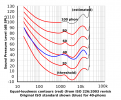The modulation distortion measurement represents the intermodulation distortion that occurs when a speaker produces bass and treble at the same time.
Just to clarify my thinking, and continue into a question that probably has been answered elsewhere already, but here we go: graph says "Bass tone = 20 Hz" and then we have Amplitude Modulation, 2nd-, 3rd order intermodulation, and a sum of all 3.
This in a graph over 20-200Hz where U2/U1 = 12dB.
Brain still asleep, but to explain how I interpret this, please correct me if I'm wrong.
U1 would be the 20 Hz tone, so we're playing the measured tone 12 dB louder than the 20 Hz one.
2nd order intermodulation distortion would be U2±U1, 2xU1 and 2xU2 Hz, so at 75 Hz measured we're looking at 55, 95, 40 and 160 Hz components. 40 and 160 also being harmonic distortion components I'm not sure if they're included here?
3rd order intermodulation would be 2xU1±U2 & 2xU2±U1", so at 75 Hz measured we're looking at (-35?),115, 130 and 170 Hz.
Personally I have two subwoofers to my desktop setup, one each at the walls to my sides. Setting the crossover to my desk speakers higher than ~80-90 Hz makes the directionality of where I perceive sounds to come from shift to the sides. I assume I get sounds coming from the subwoofers that are high enough in frequency that they're above the limit of where I lose ability to perceive direction.
The 95 and 160 Hz 2nd order IMD might be an issue for this, same with 115, 130 and 170 Hz 3rd order.
Checking the SB-1000pro we're at -10 dB when tested at @ 20+75 Hz tones, -23 dB for 3rd order IMD.
Checking your L26-ROY (excellent choice) we're at ~ -23 dB, and -30 dB for 3rd order. huge improvement.
Even if we remove some dB to ignore the components below crossover cutoff, wouldn't these levels make it hard to smoothly integrate SB-1000pro with the other speakers? Looking at the numbers, 70 dB SPL spray above 100 Hz with ~80 dB SPL at 95 Hz seems like something to improve.
I've probably read some things about the percievability of low-frequency IMD, but nothing comes to mind right now, but consider a worst case scenario of some music having a pause in everything non-bass, wouldn't the distortion from the subwoofer make its location in the room suddenly pop out as a source of noise way worse than the harmonic distortion?
I usually try to think these things through a bit more thoroughly before posting but haven't got the time right now, so I'm sorry if this is a bit uncooked.

